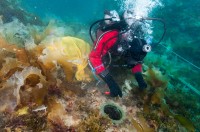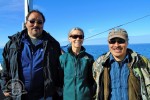 Parks Canada‘s Underwater Archaeology Team has more than doubled the dive time on the wreck of the HMS Erebus thanks to an unexpected bout of good weather this summer. Divers explored the wreck from August 28th to September 10th, logging a total of 100 dives and 109 hours underwater. The excellent visibility and comparative warmth allowed them to remove the kelp from the full 30-meter (98-foot) length of the ship. With the kelp gone, the team was able to document the structure of the ship, identify the areas damaged by ice, record the debris field surrounding it and fully survey the upper deck. Divers were also able photograph all sides of the ship and thread small cameras through openings in the deck to get a look at what’s inside.
Parks Canada‘s Underwater Archaeology Team has more than doubled the dive time on the wreck of the HMS Erebus thanks to an unexpected bout of good weather this summer. Divers explored the wreck from August 28th to September 10th, logging a total of 100 dives and 109 hours underwater. The excellent visibility and comparative warmth allowed them to remove the kelp from the full 30-meter (98-foot) length of the ship. With the kelp gone, the team was able to document the structure of the ship, identify the areas damaged by ice, record the debris field surrounding it and fully survey the upper deck. Divers were also able photograph all sides of the ship and thread small cameras through openings in the deck to get a look at what’s inside.
 Using reference points and with lines stretched between them, the team took precise measurements to draw up a complete site plan of the wreck. They then noted the location of every new artifact revealed by the removal of the kelp. They selected a total of 39 objects to recover from the ship after they were carefully documented in situ. When the good weather ran out and a fierce Arctic hit Queen Maud Gulf, those precise measurements and the guide lines enabled the divers to locate the artifacts in the murky water.
Using reference points and with lines stretched between them, the team took precise measurements to draw up a complete site plan of the wreck. They then noted the location of every new artifact revealed by the removal of the kelp. They selected a total of 39 objects to recover from the ship after they were carefully documented in situ. When the good weather ran out and a fierce Arctic hit Queen Maud Gulf, those precise measurements and the guide lines enabled the divers to locate the artifacts in the murky water.
 Among the recovered artifacts are a piece of the ship’s wheel, a sword hilt, a leather boot, a belt plate and a Blue Willow pattern dinner plate. They are in good condition but require very careful conservation. They are being sent to the Parks Canada conservation labs in Ottawa where they will be kept wet and in cold storage while the objects are analyzed for their individual conservation needs.
Among the recovered artifacts are a piece of the ship’s wheel, a sword hilt, a leather boot, a belt plate and a Blue Willow pattern dinner plate. They are in good condition but require very careful conservation. They are being sent to the Parks Canada conservation labs in Ottawa where they will be kept wet and in cold storage while the objects are analyzed for their individual conservation needs.
 Parks Canada has worked closely with local Inuit fist when searching for the wreck and in ongoing researching. Inuit tradition provided key information leading to the discovery of the Erebus, and the group of objects found on the upper deck is another confirmation of the accuracy of Inuit oral history about the wreck. The account handed down through the generations tells that the last Inuit to visit the ship before it sank assembled a number of belongings on the upper deck before leaving.
Parks Canada has worked closely with local Inuit fist when searching for the wreck and in ongoing researching. Inuit tradition provided key information leading to the discovery of the Erebus, and the group of objects found on the upper deck is another confirmation of the accuracy of Inuit oral history about the wreck. The account handed down through the generations tells that the last Inuit to visit the ship before it sank assembled a number of belongings on the upper deck before leaving.
 One of Parks Canada’s Inuit partners in the study of this history, Inuit oral historian Louie Kamookak, visited the site and performed a traditional blessing in honor of his ancestors and of the men who died on Sir John Franklin’s doomed expedition. Kamookak said about the visit: “It was a great honour to be there and do a ceremony in respect to my ancestors for their knowledge and wisdom that have played a valuable role in what we all have achieved.”
One of Parks Canada’s Inuit partners in the study of this history, Inuit oral historian Louie Kamookak, visited the site and performed a traditional blessing in honor of his ancestors and of the men who died on Sir John Franklin’s doomed expedition. Kamookak said about the visit: “It was a great honour to be there and do a ceremony in respect to my ancestors for their knowledge and wisdom that have played a valuable role in what we all have achieved.”
 The success of this season’s dive has mapped out the next steps the team will take. The bow is almost entirely intact, stable enough that divers in future seasons should be able to swim right into it. Where the structure has been too damaged by ice and time, it will have to be reinforced before any divers attempt to go inside. There is no rush; this is a long-term project. Archaeologists expect the full exploration of the wreck will take at least five years. Meanwhile, the search for the Erebus‘ companion ship, the Terror, continues.
The success of this season’s dive has mapped out the next steps the team will take. The bow is almost entirely intact, stable enough that divers in future seasons should be able to swim right into it. Where the structure has been too damaged by ice and time, it will have to be reinforced before any divers attempt to go inside. There is no rush; this is a long-term project. Archaeologists expect the full exploration of the wreck will take at least five years. Meanwhile, the search for the Erebus‘ companion ship, the Terror, continues.